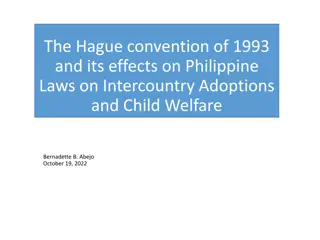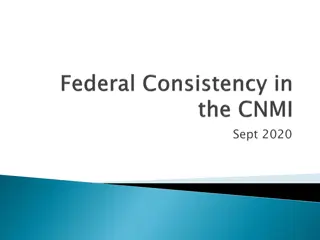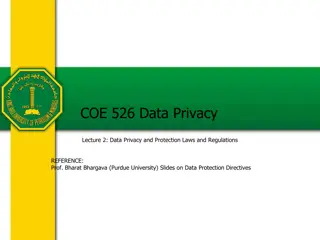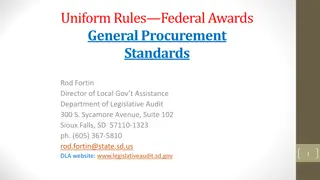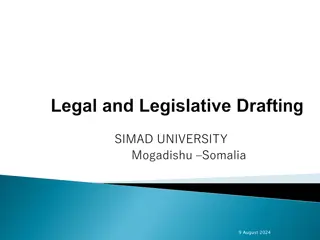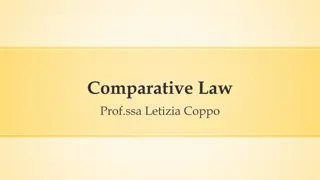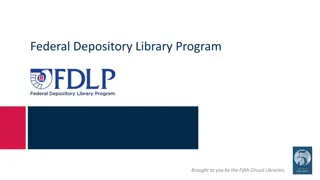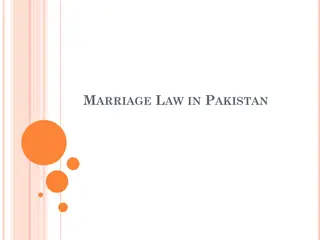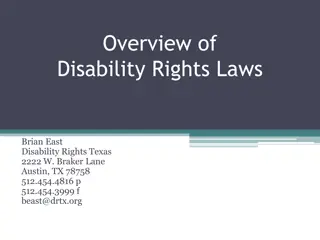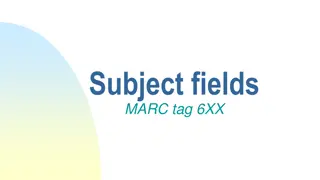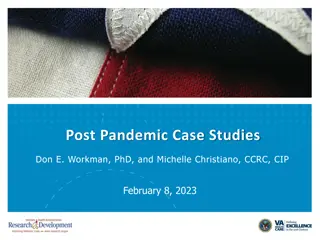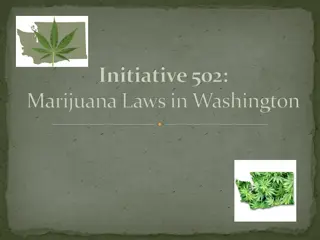Federal and State Laws on Human Subject Research Data
This informative content discusses the applicable federal and state laws related to privacy, rights of subjects, and sharing of human subject research data. It covers the Common Rule, HIPAA, FERPA, and relevant state laws like the Maryland Medical Records Act, offering insights into regulatory frameworks safeguarding research data and subjects' rights.
Download Presentation

Please find below an Image/Link to download the presentation.
The content on the website is provided AS IS for your information and personal use only. It may not be sold, licensed, or shared on other websites without obtaining consent from the author.If you encounter any issues during the download, it is possible that the publisher has removed the file from their server.
You are allowed to download the files provided on this website for personal or commercial use, subject to the condition that they are used lawfully. All files are the property of their respective owners.
The content on the website is provided AS IS for your information and personal use only. It may not be sold, licensed, or shared on other websites without obtaining consent from the author.
E N D
Presentation Transcript
Human Subject Research Data: Federal and State Laws Related to Privacy, Rights of Subjects and Sharing Theresa J. Colecchia Senior Counsel and Working Group Leader Healthcare and Research Pamela S. Rayne Chief Legal Counsel and Practice Group Leader for HIPAA and Privacy
Sources of Federal Law Applicable To Human Subject Research Data The Federal Common Rule, contained in 45 CFR Part 46, applies to all federally funded research. The State of Maryland has required all human subject research conducted in the state to follow the requirements of the Common Rule in a law known as the Hubbard Act. Certain kinds of health records are subject to the Health Insurance Portability and Accountability Act, a federal Act and its related regulations (HIPAA). HIPAA governs the confidentiality, security, use and disclosure of individually identifiable health information transmitted or maintained by a Covered Entity (referred to as protected health information or PHI ). Student records are governed by the Family Educational Rights and Privacy Act (FERPA) and some research in schools is also covered by the Protection of Pupil Rights Amendment (PPRA) that apply to research studies that include access and/or use of student education records. 2
Sources of Federal Law Applicable to Human Subject Research Data Some other categories of data that a researcher may seek to collect for research use may be subject to other federal laws. For example, CMS makes certain datasets of claims data available to researchers subject to specific approval and contractual requirements, in order to comply with the federal Privacy Act of 1974, which governs the handling of individual data contained in federal government systems. The National Center for Health Statistics in the Center for Disease Control maintains the National Death Index, which is a database of death records from across the United States and can be linked to other databases under certain terms and conditions. Mental health information and drug/alcohol treatment records are subject to a heightened level of protection under federal and state laws. 3
Relevant State Laws Maryland and Beyond There are state laws that provide additional protection to different kinds of records: The Maryland Medical Records Act applies to all medical records (not just electronic) and provides for the confidentiality of medical records, and establishes clear rules for the disclosure of medical records. Maryland public schools typically require their own IRB review of any research proposal involving student data or interactions. States are increasingly regulating some kinds of data, including: Illinois Biometric Information Privacy Act Florida s Protecting DNA Privacy Act California, Virginia and Colorado all have comprehensive consumer protection privacy laws, that govern data that may be collected in a variety of settings. 4
Common Rule Definitions of Identifiable or Readily Ascertainable The Common Rule defines a human subject as a living individual about whom an investigator obtains, uses, studies, analyzes, or generates identifiable private information or identifiable biospecimens. 45 CFR 46.102(e)(1). The definitions of what is identifiable is further refined in subsection 46.102(e)(5) and (6). (5) Identifiable private information is private information for which the identity of the subject is or may readily be ascertained by the investigator or associated with the information. (6) An identifiable biospecimen is a biospecimen for which the identity of the subject is or may readily be ascertained by the investigator or associated with the biospecimen. 5
What Did OHRP Mean By This? OHRP had proposed to include all biospecimen research as HSR requiring an IRB approved protocol and consent. Ultimately, OHRP backed off treating all biospecimens as identifiable, and made only minor edits to the existing definitions of identifiable. A new definition of identifiable biospecimen was added, and a new process was proposed to obtain expert input on when technologies may render a subject s identity readily ascertainable. This new process responds to the growing volume of information being generated and shared in research (including from biospecimens), and evolving technology that can with ease and speed re-identify information or biospecimens previously considered nonidentifiable. With an increase in the number of exemptions included in this final rule, it will be important to reconsider the potential identifiability of information and biospecimens and facilitate uniform interpretation to ensure adequate privacy and security measures are in place. Preamble to the Final Rule. 6
How Do New Technologies Figure Into This? Importantly, OHRP deferred this definitional responsibility to the agencies implementing the policy: 46.102(e)(7) Federal departments or agencies implementing this policy shall: (i) Upon consultation with appropriate experts (including experts in data matching and re-identification), reexamine the meaning of "identifiable private information," as defined in paragraph (e)(5) of this section, and "identifiable biospecimen," as defined in paragraph (e)(6) of this section. This reexamination shall take place within 1 year and regularly thereafter (at least every 4 years). This process will be conducted by collaboration among the Federal departments and agencies implementing this policy. If appropriate and permitted by law, such Federal departments and agencies may alter the interpretation of these terms, including through the use of guidance. (ii) Upon consultation with appropriate experts, assess whether there are analytic technologies or techniques that should be considered by investigators to generate "identifiable private information," as defined in paragraph (e)(5) of this section, or an "identifiable biospecimen," as defined in paragraph (e)(6) of this section. This assessment shall take place within 1 year and regularly thereafter (at least every 4 years). This process will be conducted by collaboration among the Federal departments and agencies implementing this policy. Any such technologies or techniques will be included on a list of technologies or techniques that produce identifiable private information or identifiable biospecimens. This list will be published in the Federal Register after notice and an opportunity for public comment. The Secretary, HHS, shall maintain the list on a publicly accessible Web site. 7
What Does HIPAA Require? Protect the privacy and security of an individual s health information Prohibit use or disclosure of health information unless permitted by HIPAA Are based primarily on two concepts: need to know and minimum necessary Give rights to individuals (living & deceased) regarding their health information 8
What Does This Mean for Research Access? HIPAA controls both the use and disclosure of PHI. Use = the sharing, examination, analysis, application or utilization of PHI within the Johns Hopkins Covered Entity Group by workforce members. Workforce member = employees, volunteers, trainees, and other persons whose conduct, in the performance of work for a covered entity, is under the direct control of such covered entity. Disclosure = the release, transfer, provision of access to, or divulging in any manner of PHI to persons or entities outside of the Johns Hopkins Covered Entity Group. When individuals provide express consent/authorization for use of their data for research under an IRB approved protocol, research use is straightforward and governed by the protocol and consent. 10
What About Data Without Identifiers? De-identified data can be accessed for research, but the actual performance of the de-identification is a use of the PHI, so it is a covered entity function and has to be performed by an honest broker. There are two methods of de- identification: safe harbor and expert determination. HHS provides this flow chart note that even with the removal of the 18 identifiers, if a covered entity has actual knowledge that a data set could identify individuals, it is PHI. HHS Guidance Regarding Methods for De-identification of Protected Health Information in Accordance with HIPAA, available at: https://www.hhs.gov/hipaa/for-professionals/privacy/special-topics/de-identification/index.html#guidancedetermination 11
What About a Limited Data Set? Recognizing the research need for some identifiers (such as treatment dates), researchers with an IRB approved protocol and with a signed Data Use Agreement with the covered entity may receive a limited data set for research use limited to the use set forth in the protocol and described in the data use agreement. The elements of this Data Use Agreement are spelled out in the regulations. The preparation of the limited data set again is a covered function, since it involves a use of PHI and the covered entity has an obligation to ensure that the data provided fits within the regulatory definition of a limited data set. 12
What About Waivers of Consent or HIPAA Authorization? Waiver of consent standards are similar but not identical under the Common Rule and HIPAA. Under the Common Rule, the Institutional Review Board ( IRB ) can waive consent for minimal risk studies where consent is not practicable, and where the research could not be practicably done without data being used in an identifiable format. In addition, for some kinds of studies (specifically deception studies) subjects must be told of the waiver after the fact. 13 Source: OHRP Decision Charts, available at: https://www.hhs.gov/ohrp/regulations-and-policy/decision-charts-2018/index.html#c13
How is the HIPAA Waiver Different? HIPAA waivers of authorization for research must be approved by a Privacy Board appointed by the covered entity. The IRB can serve (and for JHM does serve) as the Privacy Board as well. HIPAA waivers require the same three factors as a Common Rule waiver, with an important variation on the determination of minimal risk: The use or disclosure of protected health information involves no more than a minimal risk to the privacy of individuals, based on, at least, the presence of the following elements: 1. an adequate plan to protect the identifiers from improper use and disclosure; 2. an adequate plan to destroy the identifiers at the earliest opportunity consistent with conduct of the research, unless there is a health or research justification for retaining the identifiers or such retention is otherwise required by law; and 3. adequate written assurances that the protected health information will not be reused or disclosed to any other person or entity, except as required by law, for authorized oversight of the research project, or for other research for which the use or disclosure of protected health information would be permitted by this subpart HHS HIPAA Guidance Research, available at: https://www.hhs.gov/hipaa/for-professionals/privacy/guidance/research/index.html 14
JHM Data Trust Council Provides Johns Hopkins with technical infrastructure, standards, policies and procedures, and organization needed to govern uses and disclosures of patient and health plan member-related data Responsible for overall governance of data stored in the clinical enterprise systems of JHM entities If a research protocol involves PHI, a limited data set, or sensitive de-identified data involving 500 or more subjects from an entity within the JHM covered entity group, DTC research subcouncil will be required to review. The DTC research subcouncil also reviews other research requests, including the creation of a data registry or requests for data that are particularly high risk. https://intranet.insidehopkinsmedicine.org/data_trust/faqs/research-data-requests.html 15
JHU Researchers Outside the Covered Entity The Homewood IRB relies on the JHM IRB to approve research involving PHI: Reviews of proposed research projects from Homewood that: (a) involve the collection, transfer, or use of data subject to the Health Insurance Portability and Accountability Act of 1996 ( HIPAA ); (b) that take place in Johns Hopkins Health Systems (JHHS) space; (c) that is subject to the regulations of the Food and Drug Administration (FDA); or (d) involve biomedical or clinical research when Homewood lacks committee expertise to review the proposed research; shall be reviewed by the JHUSOM IRB. To recruit human subjects from JHM facilities, a clinician or treatment staff will be required to directly approach patients. More information is available here: Patient Recruitment and Referral for Research (hopkinsmedicine.org). To access deidentified and limited data sets for research, there is a detailed FAQ describing the pathways to quick approval here: Access to Patient Data for Research: Frequently Asked Questions (hopkinsmedicine.org). 16
Questions? Why don t we just have people sign a consent that we can use their tissue and data for whatever we want forever and ever? How do I find a collaborator in the School of Medicine to be a co-PI or co-I on my study? Why can t I just get into Epic and do my own data extraction? Can I get data from the CRISP database? Research and Quality Improvement - Improve Outcomes and Enhance the Patient Experience | CRISP | Improve Outcomes and Enhance the Patient Experience | CRISP (crisphealth.org) Do patients ever complain about researchers? 17
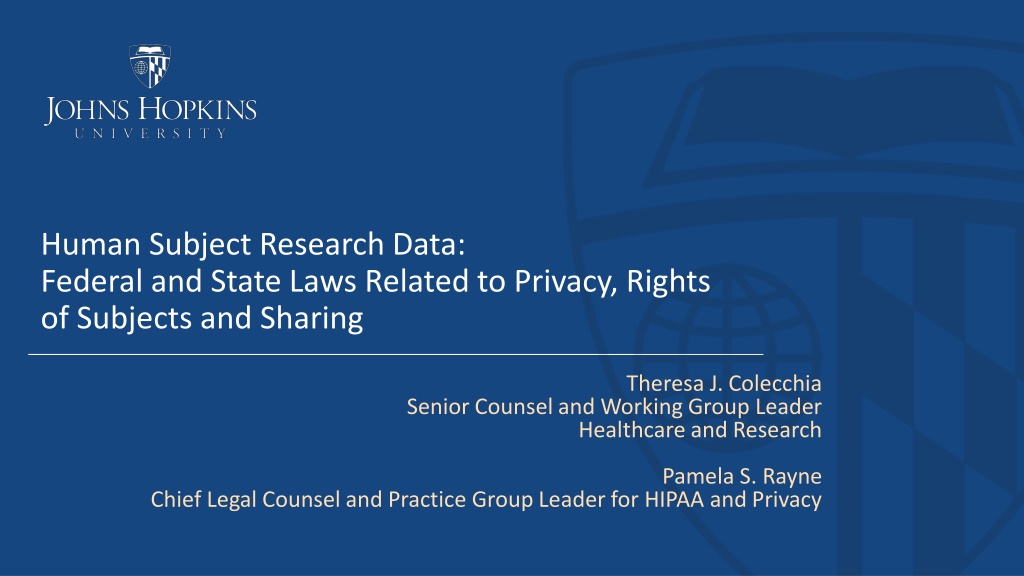
 undefined
undefined







